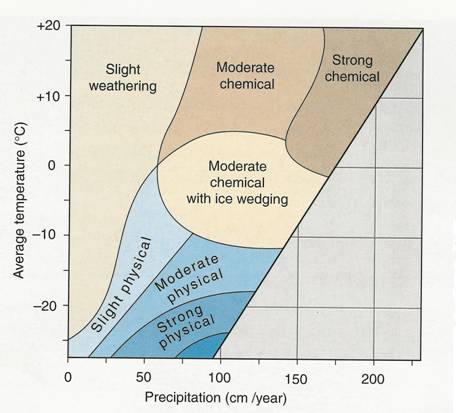Peltier Diagrams
Physical
Weathering
• Frost shattering is important
in a climate where temperatures fluctuate at around 0oC but if a
climate is too cold, or too warm, or too dry, or too wet (covered by
vegetation) it will not operate.
Chemical Weathering
•
This increases as temperature and rainfall totals increase. The rate of chemical weathering (around about) doubles (Increase by about 2 1/2 times) with every 100C temperature increase.
This increases as temperature and rainfall totals increase. The rate of chemical weathering (around about) doubles (Increase by about 2 1/2 times) with every 100C temperature increase.
•
Recent theories suggest that in
humid tropical areas, direct removal by solution may be a major factor in the
lowering of landscape, due to the continuous flow of water through the soil.
•
Chemical weathering is strong
in warm moist climates e.g. rainforests.
Weathering Regions
·
Peltier constructed this
diagram as an attempt to predict weathering at a place in the world by the mean
annual rainfall and mean annual temperature. Physical and chemical weathering
operates together at the same time and at the same place, but usually one
process is more significant than the other.

It is a software to create automaticaly Peltier Diagrams?
ReplyDeleteWhat locations are affected most by biological weathering?
ReplyDeleteNormally areas with much vegetation as there ae more organisms to weather the rocks
Deleteareas with dense vegetation cover for humus and high temperature to increase the rate of decomposition as well moisture hence that region can be the humid tropics or sub humid tropics
Deleteoverpopulated areas are usually affected by biological weathering because of lack of habitats and also mining activities ,borehole drilling,road constructions do cause biological weathering
ReplyDeleteHW can l explain the regions affected by physical and chemical weathering
ReplyDeleteik im a bit late but i dint know the answer
Deleteyou suck
ReplyDeleteFuck u
ReplyDeleteU didn't have main ideas of Peltier
ReplyDelete